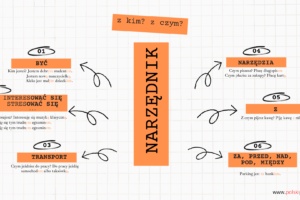
The Mysterious World of Polish Noun Gender. What does it mean that something is męski, żeński or nijaki?
Polish, like many other Slavic languages, has grammatical gender. Singular nouns are categorized as either masculine (rodzaj męski), feminine (rodzaj żeński), or neuter (rodzaj nijaki). Gender is also important for plural nouns, although the issue is generally less complicated than with singular nouns. This topic will be covered in a separate post.
Each noun in Polish has a grammatical gender, which is indicated by its ending and affects the forms of other words in the sentence. For example, the gender of a noun determines the form of adjectives, pronouns, and sometimes even verbs that are used to describe or refer to that noun. Take a look at 3 almost exactly the same sentences with only one difference- nouns with a different gender are used. In the first sentence, its chłopak (boy) – grammatically masculine gender, in the second – dziewczyna (girl) grammatically feminine, and in the last sentence is dziecko (child) – neutral.
Ten wysoki chłopak był w domu. (This tall boy was at home)
Ta wysoka dziewczyna była w domu. (This tall girl was at home)
To wysokie dziecko było w domu. (This tall child was at home)
In Polish, grammatical gender is not always determined by the biological gender or the natural sex of the object being described. For example, in a category of fruits, we have nouns of all 3 different genders: banan (banana) – męski, gruszka (pear)- żeński, jabłko (apple) nijaki.
Why do Polish nouns have gender?
The origin of grammatical gender in Polish and other Slavic languages is not entirely clear. However, it is believed to have developed from an older system of noun classification that was based on natural gender (i.e., the biological sex of the object or person being referred to).
Over time, this system of natural gender classification evolved into a grammatical gender system, where nouns are classified into three gender categories (masculine, feminine, and neuter) based on various linguistic features, such as the noun’s ending or phonetic characteristics.
The use of grammatical gender in Polish allows for more precise and nuanced communication by enabling speakers to convey information about the relationship between different elements in a sentence. For example, in Polish, if you will say piękna – beautiful it is clear that it refers to noun of feminine grammatical gender (for example girl- dziewczyna or book – książka).
How to determine the gender of Polish nouns?
In Polish, the gender of a noun is typically indicated by its ending and it does not depend on context. Here are some general guidelines for determining the gender of Polish nouns:
- Masculine nouns (rodzaj męski) often end in a consonant. For example pies (dog), dom (house), telefon (telephone).
- Feminine nouns (rodzaj żeński) often end in –a. For example: kawa (coffee), kobieta (woman), ulica (street).
- Neuter nouns (rodzaj nijaki) often end in –o, –e, –ę –um. For example: dziecko (child), miasto (city), muzeum (museum).
It is important to note that there are many exceptions to these rules.
Most common exceptions
While there are some general rules for determining noun gender based on their endings, there are also some exceptions.
Masculine (rodzaj męski) – there is a bunch of words that end with a – ending typical for the feminine gender but are in fact masculine. The most common and most often used are:
- kolega (friend)
- mężczyzna (men)
- tata (dad)
- poeta (poet)
- artysta (artist), dentysta (dentist), optymista (optimist), pesymista (pesimist)
We need to remember that from the one side they are masculine so they will force the remaining words in the sentence to change to masculine:
Ten kolega jest inteligentny.
not
Ta kolega jest inteligentna.
But from the other side because they end with a feminine ending -a they themselves will follow a feminine declination pattern. On the example of narzędnik (Instrumental case):
On jest sympatycznym tatą.
not
On jest sympatyczną tatą.
So in the sentences where exceptional masculine words with -a end, we will have a mix of some sort. The noun itself will change endings typically for the feminine gender but at the same time will force the remaining words in the sentence to change for masculine.
Feminine (rodzaj żeński) – there are certain words that are feminine despite having endings different than a:
- noc (night)
- mysz (mouse)
- dłoń (hand)
- twarz (face)
- miłość (love)
Neutral (rodzaj nijaki) – there are few words which despite having a -um ending are masculine. Among exceptions there are also words that are neutral with different endings as -u:
- kostium (costume)
- tofu
- menu
Fun facts about noun gender in Polish
The most common grammatical gender for nouns is masculine. It is estimated that around 60-70% of Polish nouns are masculine. Feminine nouns make up around 20-30% of Polish nouns, and neuter nouns make up the remaining 10-20%.
Professions have different gendered forms depending on the gender of the person performing the profession. For example, lekarz is masculine and means “doctor,” while lekarka is feminine and means “female doctor.”
Rarely, but it may happen that word will have multiple genders depending on dialect or region. Ziemniak (potato) is masculine. Pyra dialectal variation of ziemniak in the Wielkopolska region of Poland is feminine in gender.
Why it is important to know the grammatical gender?
Knowing the gender of nouns is important because it affects the grammatical structure of a sentence. In Polish, the gender of a noun determines the forms of other words that are used in relation to it, such as adjectives, pronouns, and sometimes verbs.
If you don’t know the gender of a noun, you may use the wrong forms of other words in the sentence, which can lead to grammatical errors and make it more difficult or even impossible for others to understand you. Only by knowing the gender you will be able to conduct proper declination and choose a proper ending for a noun in every grammatical case. We can say that learning how to distinguish the grammatical gender of a noun is like laying strong foundations when building a house; it is a fundamental skill in learning Polish.



